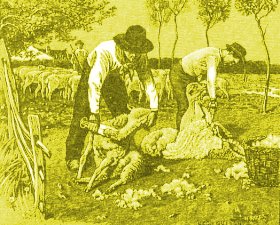1. Put parentheses ( ) around each prepositional phrase. 2. Write a "P" over every passive verb. 3. Underline subjects once, finite verbs twice, and label complements (PN, PA, (IO, DO. Put and "R" before the label of retained complements.) 4. Place brackets around each subordinate clause. If the clause functions as a noun, label its function (PN, IO, DO, OP) above the opening bracket. If it functions as an adjective or adverb, draw an arrow from the opening bracket to the word that the clause modifies. 5. Put a vertical line at the end of every main clause. 6. Try rewriting this passage by changing the passive verbs into active voice. Sheep are washed and sheared some time in the month of June. This should be done quite early in the month, before the hot days begin. It is fine sport for those who look on, but not much fun for the sheep. It is best for the sheep to have the wool taken off; otherwise they would suffer in the summer time. When the time comes for washing the sheep, they are driven to a pond or a little river. Then they are thrown into the water, one at a time. The men who are in the water catch them, and squeeze the wet wool with their hands to get the dirt all out of it. When the wool is thoroughly dried, the sheep are taken to the shearer; and he cuts off the wool with a large pair of shears. It is then dyed, spun, and woven into cloth. In a short time, before the cold winter comes, new wool grows out on the sheep. By the coming of spring there is so much, that it must be cut off again. |
||||||||
